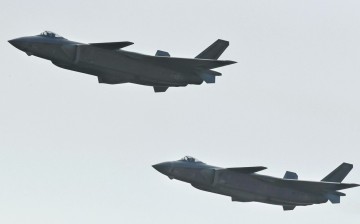
The deployment of the J-20 stealth fighter for combat service and Su-35 jets for drills over the South China Sea shows the air force has "significantly boosted" its capacity to handle security threats from the sky, according to the People's Liberation Army.
Wang Mingzhi, a senior researcher with the PLA Air Force Command College, also said on Monday that patrols over the South China Sea would become "more regular".
The air force on Friday confirmed that its J-20 stealth fighter was combat-ready after it entered military service in September.
The announcement came two days after Beijing said the Su-35 fighter jets it bought from Russia had taken part in a combat patrol over the contested South China Sea.
The Su-35 is powered by two turbofan engines, giving it a range of about 3,500km on internal fuel, making it one of the most advanced multi-role fighters.
"The addition of Su-35 fighter jets will enable the Chinese military to handle the complicated air and maritime situations of the South China Sea," Wang was quoted as saying in an article posted on the air force's official Weibo account on Monday.
With the J-20, which has two jet engines for extra power, now in combat service, the air force has "significantly boosted its strength to handle new air security threats", Wang said.
"The air force has transformed advanced technology into combat strength faster than the air forces of other powerful nations," he said.
China is involved in bitter territorial disputes with its Southeast Asian neighbours over the South China Sea, and the United States has conducted freedom of navigation operations in the disputed waters.
On Tuesday, British Defence Secretary Gavin Williamson said UK warship HMS Sutherland would sail through the South China Sea next month to assert freedom of navigation rights, prompting Beijing to warn "relevant sides" not to "create trouble out of nothing".
China is pushing ahead with a massive modernisation programme of the military, with the focus on combat readiness and training. Inspecting troops in southwestern Sichuan province on Tuesday, President Xi Jinping called for measures to strengthen combat power and aerospace development to build a world-class army.
"[We need to] advance rocket-launch and combat capabilities and integrate them across the entire operation to build a first-class army ... and aerospace power," Xi was quoted as saying by state broadcaster CCTV.
Shanghai-based military expert Ni Lexiong said aerospace development - including the J-20 and Su-35 - was an important part of the air force's "big step forward".
"Aerospace technology will provide the air force with protection and support through surveillance, targeting and precision strikes," Ni said.
He said the recent progress announced by China was aimed at demonstrating its capabilities and "surprising foreign countries, especially the United States".
"These jets are now ready years ahead of when the United States was expecting them to be. This is going to deter the US and it also means China is prepared as relations with the US become more tense," Ni said.
Collin Koh, a military expert with the maritime security programme at the S. Rajaratnam School of International Studies in Singapore, said the J-20 and Su-35 jets could potentially be used in a number of flashpoints in the region, including on the Indian border, the Taiwan Strait and the East and South China seas.
"The risk of encounters and clashes has intensified" with more highly advanced fighters such as the J-20 or Su-35 operating over contentious maritime zones, Koh said.
But Chinese military expert Adam Ni from the Australian National University said it was "too optimistic" to see the deployment as a leap forward in China's deterrence capability.
"The exact operational status and readiness of the J-20 remains unclear. It can take years from initial deployment to achieve full operational status," he said.


























